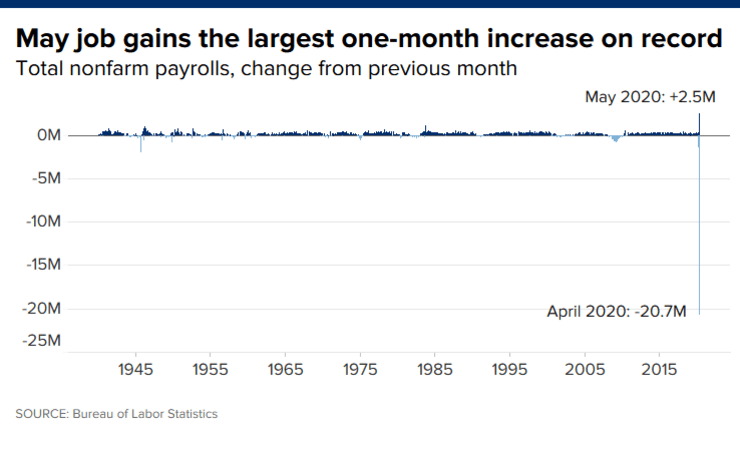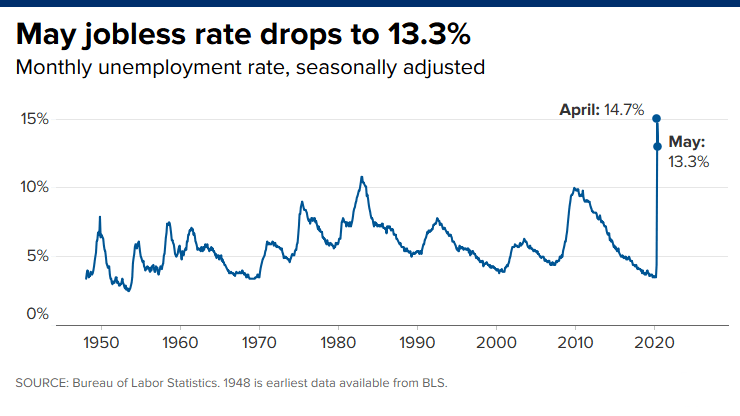Employment stunningly rose by 2.5 million in May and the jobless rate declined to 13.3%, according to data Friday from the Labor Department that was far better than economists had been expecting and indicated that an economic turnaround could be close at hand.
Economists surveyed by Dow Jones had been expecting payrolls to drop by 8.33 million and the unemployment rate to rise to 19.5% from April’s 14.7%. If Wall Street expectations had been accurate, it would have been the worst figure since the Great Depression.
As it turned out, May’s numbers showed the U.S. may well be on the road to recovery after its fastest plunge in history.
“It seems the damage from the nationwide lockdown was not as severe or as lasting as we feared a month ago,” said Scott Clemons, chief investment strategist at Brown Brothers Harriman.
The stock market roared higher following the report as the Dow Jones Industrial Average gained 800 points as of 11 a.m. ET. Government bond yields raced higher as well, with the benchmark 10-year Treasury most recently at 0.91%.
The May gain was by far the biggest one-month jobs surge in U.S. history since at least 1939. The only previous month to register more than a million jobs was September 1983, at 1.1 million.

“Barring a second surge of Covid-19, the overall U.S. economy may have turned a corner, as evidenced by the surprise job gains today, even though it still remains to be seen exactly what the new normal will look like,” said Tony Bedikian, head of global markets at Citizens Bank.
The jump in employment almost perfectly mirrored the 2.7 million decrease in workers who reported being on temporary layoff. Economists had expressed doubt as to whether that would be the case or if more job losses would be permanent.
“The glimmer of hope in that [April] report, as awful as it was, was that 78% of the people who lost their jobs believed that loss would be temporary,” Clemons said. “It turns out that optimism seems to have been warranted. As the economy responded and people went back to work, the jobs were still there.”
Those jobs tilted toward full-time, which added 2.2 million , while part-time workers gaining jobs numbered 1.6 million.
The huge increase in jobs “suggests that the US economy is more resilient than expected,” said Seema Shah, chief strategist at Principal Global Investors.

The addition in May was tempered somewhat by a revision in April that increased the initially reported loss by 150,000 to 20.7 million. March’s total also saw a substantial revision, from 881,000 to 1.4 million. On net, revisions added 642,000 to the already staggering job losses for the two months.
Also, the declines in the unemployment rate were not spread equally: white men saw a decline from 12.4% to 10.7% and white women dropped from 15% to 13.1%. However, the rate for African-Americans edged higher by one-tenth of a percentage point to 16.8%, though the rate for men fell from 16.1% to 15.5%.
Leisure and hospitality workers made up almost half the increase last month, with 1.2 million going back to work after a reported loss of 7.5 million in April. Jobs in bars and restaurants increased by 1.4 million as states began to relax social distancing measures.
Construction was the next biggest gainer with 464,000, making up for about half of April’s losses. Education and health services rose by 424,000 and retail surged by 368,000 after plunging by 2.3 million a month previous.
“It appears that businesses began rehiring workers earlier and in greater numbers than expected, a trend that is likely to continue as lockdowns ease around the country,” said Eric Winograd, senior economist at AllianceBernstein. “To be clear: things are very far from normal in the labor market. But the pace of improvement, if sustained, suggests more reason for hope in the second half of the year than we have seen from any previous data release.”
The other services category rose by 272,000 thanks largely to a jump of 182,000 for personal and laundry services. Coming after a decline of 1.3 million positions, manufacturing jobs increased by 225,000 despite broader signals that the sector is still in contraction.
Average hourly earnings actually decreased by 6.7% from a year ago, but for the right reasons as more lower-wage workers came back to work. April saw an unprecedented jump of 8% that came primarily because the cuts were so heavily weighted towards lesser-paying service industry jobs.
The average work week rose 0.5 hours to 34.7 hours. That included a gain of 0.8 hours for manufacturing to 38.9 hours.
After an exodus in April, the labor force in May increased by 1.75 million, pushing the participation rate to 60.8% from 60.2% in April. The total employment level as measured by the survey of households rose by 3.84 million while those who reported being unemployed plunged by 2.1 million, though it was still elevated at 21 million.
The stunning gains come just three months after the U.S. had boasted a 3.5% unemployment rate, the lowest in 50 years, then saw that erased in an instant. The U.S. economy had been enjoying the longest expansion in its history but had to go into almost complete lockdown due to stay-at-home orders issued across the country.
In recent weeks, all states have begun to reopen, but the unemployment level is expected to remain elevated as social distancing measures stay in place. A more encompassing unemployment figure that includes discouraged workers and those holding part-time jobs for economic reasons fell to 21.2% from 22.8%, the highest in the series history.








